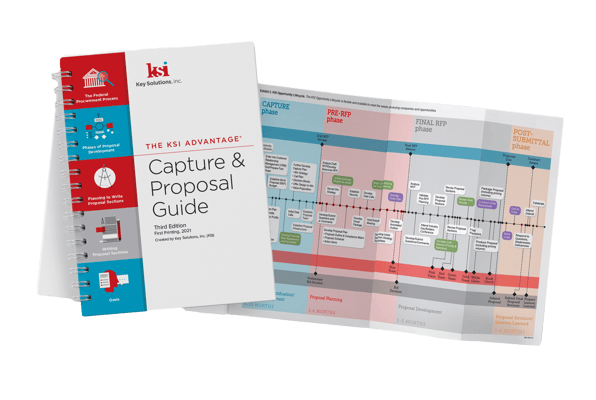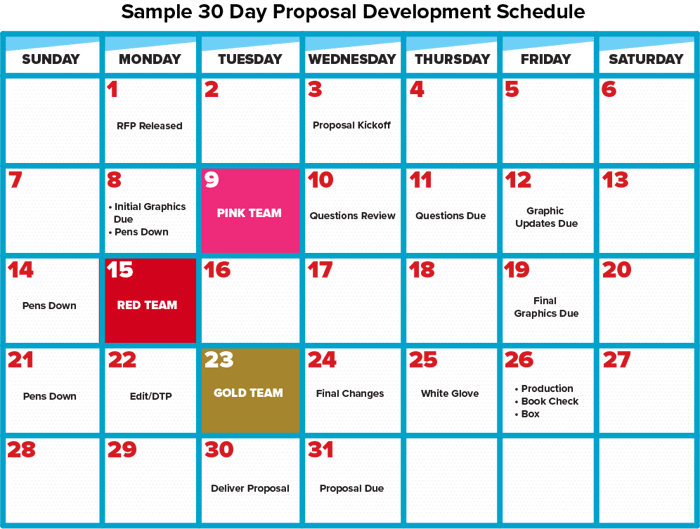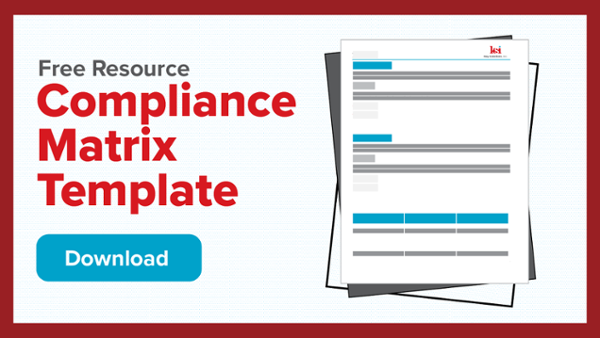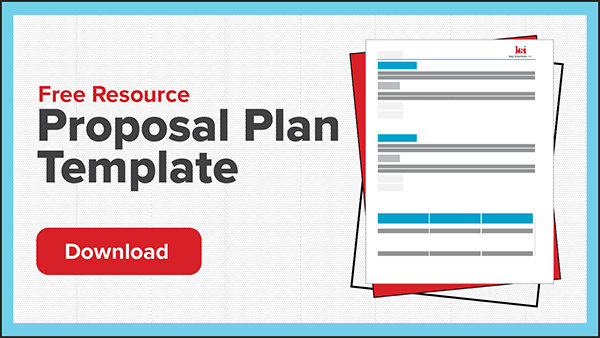
The Proposal Management Plan is the operations plan for the Proposal Manager and the proposal team to answer the RFP.
If that sounds incredibly important, that’s because it is! It is your map going forward; a combination of agenda, reference, and strategy. Constructing the Proposal Management Plan for distribution during the Kickoff Meeting is the most important job of the Proposal Manager, and is essential for supervising the writers and keeping things on schedule during proposal development.
The Proposal Management Plan incorporates the win strategy, major themes, discriminators, and customer hot buttons. All of this information is used to create thoughtful proposal schedules, assignments, allocations, and to drive uniform presentations. That sounds like a lot, but critical tasks like these are just what Key Solutions and our KSI Advantage™ Capture & Proposal Guide are here for! Our Guide contains many tips and tools to help Proposal Managers develop plans that are both manageable and efficient.
 Let’s briefly cover some of the most important parts of a Proposal Management Plan and see what our Guide can do to help!
Let’s briefly cover some of the most important parts of a Proposal Management Plan and see what our Guide can do to help!
The Proposal Schedule:
The Proposal Manager, with help from the Capture Team, develops the Proposal Schedule. It’s a detailed guide to the proposal effort, highlighting milestone dates like question submittals, formal reviews, and deadlines. Make sure your schedule is realistically paced and avoids weekend work whenever possible. You should always aim to create a plan that keeps team morale high!
Below is a sample schedule based on a 30-day turnaround. For a more macro idea of how to plan a Proposal Schedule, see Exhibit 2 in the Guide for the KSI Opportunity Lifecycle.

Evaluation Factors Scoring Tree:
This scoring tree breaks down Section M based on the “weights,” or importance, of each evaluation factor, as indicated by the RFP. The Proposal Manager should include exact language from Section M to make sure writers have a clear understanding of the government’s requirements. Because it graphs each section according to importance, the tree is often used to help decide page allocation.
A detailed example of an Evaluation Factors Scoring Tree is shown below and in the Guide as Exhibit 2-19.

Detailed Proposal Outline:
The Proposal Outline is a dissection and summary of the RFP, organized according to Section L, with additions from Section M and the SOW when appropriate. The Proposal Outline should be constructed in the exact way the RFP is organized. This makes compliance mapping easier for evaluators, which is important since evaluators generally don’t like to spend too long reading a proposal. With this in mind, your goal while writing the proposal should be to make the criteria of Section M as easy to find as possible.
To see just how Section L and Section M requirements get turned into an Outline, check out Exhibit 2-20 in the Guide.
Proposal Integration and Compliance Matrix:
This matrix is the prime tool to ensure a compliant proposal. It uses the organizations of the Proposal Outline and orders all requirements from the RFP, amendments, Q&As, and anything else in-between! In addition to listing the requirements, the Proposal Integration and Compliance Matrix can include page constraints, writing assignments, themes, subthemes, and strategy.
As you can probably tell by now, the Proposal Integration and Compliance Matrix is one of the most important outputs of a Proposal Management Plan. This matrix will be the primary tool your team uses to conduct formal reviews, so it needs to be excellent and precise!
An example Compliance and Integration Matrix can be seen as Exhibit 2-22 in the Guide, and a blank Compliance and Integration Matrix Template is ready for you and your team to fill out whenever you need it in Appendix-56. We've also made it available to you to download below.
Configuration Control Plan:
This is another term for version control, an element of proposal infrastructure. The Proposal Manager or Coordinator establishes Configuration Control with consultation from the Production Manager. It identifies each proposal component and uses a computer program to track and record all activity within the proposal documents and files.
During the Kickoff Meeting, the Proposal Manager should brief their team on the Configuration Control process and instruct them on how to use the selected software (e.g. SharePoint, Priva, VPC). For more on this, see Section 2.1.9 Establishing the Proposal Infrastructure in the Guide.
Visual Package:
Every proposal needs to have a standardized look: font type, font size, margins, and color palette. Usually, many of these are dictated by the RFP, but even when they aren’t, they still need to be uniform. It wouldn’t do to submit something sloppy! Remember that proposal will almost always have multiple people writing on it, but it should never look like it.
Components of a Visual Package include:
- Writing templates – to be used by writers for each section;
- Graphics templates – featuring the color palette;
- Hotbox, Theme Box, and Icon designs – also featuring the color palette;
- Resume and Past Performance templates; and
- Cover design.
For more detail on the parts of a Visual Package, see Develop the Visual Package in Section 2.3.4, Develop the Proposal Management Plan in the Guide. You can also check out our article, A Step-by-Step Guide to Proposal Production.
Kickoff:
Lastly, you need to plan for your Kickoff. This will be an informative and motivational meeting, not a strategy session, so plan to discuss any problems that come up during the discussion later. It helps to prepare an Agenda and stick to it to keep everyone on track. A sample Kickoff Agenda can be seen in Exhibit 2-25.
During the meeting, perform introductions and give an overview of the opportunity and competition. Discuss win strategy, impart your Proposal Management Plan, and talk about the path forward. Have a brief Q&A, but again, do not engage in any major problem-solving. The Kickoff is about organization, not deliberation. Make sure everyone leaves the meeting understanding your Proposal Management Plan and their assignments within it.
In Conclusion:
You can see now why a solid Proposal Management Plan is so essential. Your schedule, assignments, outline, and compliance data all stem from the work you put into your plan as a Proposal Manager. Its purpose is to minimize hassle during Proposal Development and to help create a winning proposal. If you're a new Proposal Manager, check out this article to get started.
When you work in this business, sometimes you have to plan how to plan! The KSI Advantage™ Capture & Proposal Guide is a valuable tool for anyone in the federal proposal world. It details Capture, Proposal Management, Proposal Writing, and even Orals Presentation in a straightforward, accessible way. Get yours and see the difference it makes!









